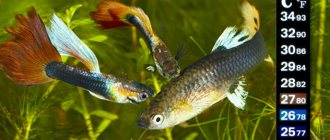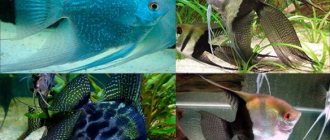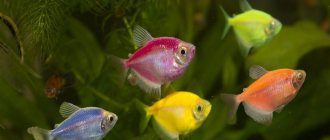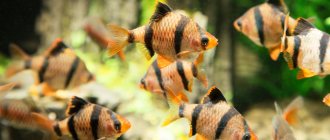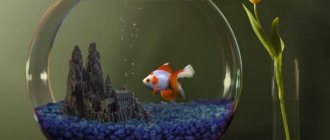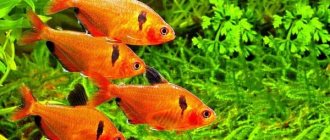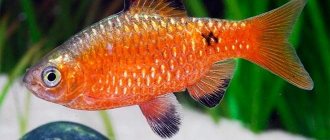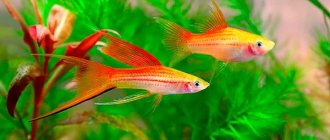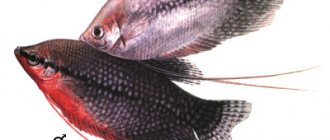Description
The butterfly will decorate the aquarium of experienced and amateur aquarists. Ramirezi fish are not suitable for beginner aquarists due to their sensitivity to water parameters.
Appearance
The body of the apistogram looks oval. The fish is small in size: up to 5 cm in an aquarium, in nature – up to 8 cm. The color is rich, they come in blue, olive and yellow colors. There is a pattern of shiny dots on the body, head and fins. Black stripes are located on the head and abdomen. The fins are high. The first rays of the dorsal fin are dark. Butterflies have large red eyes.
Character
The fish's temperament is peaceful, except during the spawning period. The apistogramma scares fish that invade its territory. Rarely attacks. Unlike other cichlids, Apistogramma do not damage plants.
Lifespan
In good conditions and at 26 degrees, ramirezi live up to 4 years. At 27–30 degrees they live up to 3 years. In cool water they are susceptible to diseases, so lowering the temperature does not always prolong the life of butterflies.
general characteristics
The eyes are bulging, directed in opposite directions, with a slight displacement forward. In fry up to 4 months they are not distinguished. The shape of the eyes varies: cone-shaped, cylindrical and spherical. At six months of age, the diameter of the eyeball can reach 5 cm. The body is round in shape. Height can reach 25 cm, although at home it is usually within 12 cm.
They are divided into scaly and scaleless. Scaly ones are divided into plain and calico. They have a metallic sheen. In scaleless animals this reflection is absent. The tail is forked and exceeds the size of the body. It can be shaped like a butterfly or flowing veil.
The color is most often pink and white. Plain fish are usually white or red with a scarlet tint. As they grow older, they may turn black. The color of the fins is either white or with black or red splashes.
Life expectancy with proper care is: for short-bodied veil-tails 15 years, for long-bodied ones - 30 years.
Kinds
The tanks contain natural ramirezi and selection forms. The natural apistogram has increased immunity.
Ramiresi
The general color is yellowish, the forehead is red. More blue in color appears during spawning. A dark spot limits the eye. The abdomen is crimson or orange. The fins are translucent.
Electric blue
The apistogram is a rich turquoise color, the front part is red. The intensity of the colors of the ramiresi apistogram depends on the conditions of detention and light. The fins are bright neon. Lives for 2 years. It is also called ramiresi blue neon.
Ramirezi gold
Golden variety. Apistogramma gold is lemon-colored with turquoise sparkles on the sides and fins. The male has a reddish dorsal fin.
Balloon
A butterfly with a short body shape and a rounded belly. Due to severe deformation of the body, she often gets sick.
Veiled
Selective form of the Ramirez butterfly. Its multi-colored coloration and long veil-like fins make it a very attractive fish. In addition to dark spots, there are red, purple and yellow spots on the body. The characteristic rows of neon dots have also been preserved.
Content
Keeping and caring for butterflies is easier than other cichlids. They do not require a very large aquarium and are less picky. Take care of quality equipment, good filtration and aeration, proper proximity and diet.
Aquarium
The recommended aquarium volume for a pair of cichlids is from 40 liters. An 80-liter aquarium is enough for a small flock.
Priming
Place sand or fine gravel at the bottom; apistogrammas sometimes dig it. Sharp and large stones can injure the fish.
Water
Butterflies are demanding on water quality. Provide the fish with clean water; they do not tolerate cloudiness or sudden changes in parameters. In a 40–80 liter aquarium, change part of the water 1–2 times a week by 10–15%. In large tanks, change the fluid no more than once a week. Avoid strong water movement.
Optimal parameters.
| rigidity | 5–12 dGH (soft water) |
| acidity | 6.5–7.5 ph |
| water temperature | 26–30 degrees |
Lighting
The Apistogramma fish is unpretentious to light. Choose bright overhead lighting that will be comfortable for fish and plants. Make sure that the lamp does not heat the water too much. The colors of the fish are better revealed in the light of the cold spectrum. You can add a special lamp that enhances the color. Avoid incandescent lamps, their spectral composition and heat output are not suitable for an aquarium with apistograms.
Plants
Create shaded areas with floating plants:
- Riccia floating;
- duckweed;
- salvinia;
- hydrocotyls.
An aquarium with apistogramma contains any plants. Give preference to green plants:
- hornwort;
- elodea;
- Vallisneria in the aquarium;
- ferns;
- limnophils.
Red-leaved species (Ludwigia, Cryptocoryne) are undesirable; butterfly fish look less impressive with them.
Habitat arrangement
Place the necessary equipment:
- external or internal filter;
- compressor;
- heater.
View this post on Instagram
#Mikrogeophagus #ramirezi #male #guarding his #nest in our #losllanos #biotope in the #shop #Aquariumspeciaalzaak #Utaka #aquariumspecialists #aquatlantisaquarium
A post shared by Aquarium Speciaalzaak Utaka (@utakaamersfoort) on May 15, 2021 at 1:55pm PDT
Place several flat dark rocks on the ground for spawning. To achieve a natural habitat feel, add alder cones, almond leaves and tree roots. Also suitable as decorations:
- grottoes;
- driftwood;
- pots.
Avoid metal elements that change the composition of the water.
Diseases of the Bolivian butterfly apistogramma
Bolivian butterflies are one of the sickest aquarium inhabitants.
Apistogrammas of this species are very sensitive to changes in conditions of detention.
When the water temperature drops, the fish weaken and rise to the upper water layers. They gasp for air and swellings may appear under the gills. Pets can be helped if, at the first adverse events, the water temperature is increased.
Apistograms react acutely to replacing the full volume of water or most of it. This event can cause a number of diseases. Fish do not tolerate increased concentrations of chlorine, ammonia and sodium salts. A complete change of water in the aquarium can cause a brain tumor in the fish.
Parasitic organisms can cause hexamitosis and ichthyophirius in fish.
Incurable diseases of Bolivian butterflies include lymphocytosis or hypertrophy. Gray nodules and black spots appear on the body of a sick fish.
With tuberculosis and dropsy, the fish have bulging eyes.
Apistograms often suffer from overeating, which causes inflammatory processes in the digestive system. In most cases, a couple of fasting days, during which the fish are not fed at all, will help with this problem.
Apistogramma Bolivian butterflies react very sharply to various stressful situations. In particular, these fish cannot be transplanted into an aquarium with different water parameters. The need to adapt to new conditions and surroundings can cause the death of a fish.
If the disease is accurately identified, drug treatment can begin. In the event of a general deterioration in the condition of Bolivian butterflies, you need to increase the temperature of the water in the aquarium - this usually helps the fish to recover.
Care
Mandatory butterfly care includes:
- weekly water changes;
- water quality testing;
- soil siphon;
- preparing a varied diet;
- timely detection and treatment of diseases;
- maintaining stable water parameters.
Combine soil cleansing with weekly water changes. Test your ammonia levels with water tests once a week.
Feeding
Butterflies tend to overeat, so feed the fish as much food as they eat in 5 minutes. After feeding, remove uneaten food particles. The omnivorous nature of fish allows them to have a varied diet.
Suitable frozen and live foods:
- bloodworm;
- daphnia;
- coretra;
- Cyclops.
Diversify your diet with plant foods:
- dandelions;
- nettle;
- cabbage;
- cucumbers;
- branded food.
Use dry food as a supplement to your diet.
Conditions of detention
Experienced aquarists know that this species is best kept in a separate aquarium due to the special conditions required for its inhabitants.
Aquarium
For these fish, depth is not important, so you need to choose an aquarium for them based on this. Its depth should be from 20 to 35 cm. It should also be wide enough. It is desirable that the aquarium contains aquatic plants with large leaves located on the surface. In this case, the free surface must be significant.
The aquarium should be moderately shaded. The required volume for keeping an adult is 45-50 liters. If there are several fish, then the volume of the aquarium should be on average 80-100 liters, but more is possible. It must be equipped with a lid to prevent fish from jumping out of the water. The distance between the lid and the water surface is at least 12-15 cm.
It is better that these predatory fish are the same size and approximately the same age. Younger individuals who are smaller in size can cause aggression from their older and, accordingly, larger relatives.
Bottom arrangement is not that important for pantodons, since they spend most of their time near the surface. Therefore, for comfortable living, it is enough to place pebbles at the bottom. It is desirable that the stones be dark in color.
Water parameters
The difficulty of caring for these underwater inhabitants is that the aquatic environment for them has its own characteristics, which must be constantly monitored.
Required water indicators:
- volume – from 45 l;
- temperature regime – from 25 to 30 degrees;
- depth 15 – 25 cm;
- hardness – no more than 12 dGH;
- acidity – from 6 to 7.5.
Equipment
Pantodon does not like bright light, so the aquarium should not be equipped with a bright lighting lamp. Lighting should be soft and dim. You should choose plants that do not require a lot of light to grow. If the leaves have not reached the required size to create shade, you need to wait until they grow to normal size, and then add the fish to the aquarium.
The lamp should illuminate only part of the surface of the water. Most often, a fluorescent lamp protected by a special waterproof cap is used for this purpose. It should work no more than 10-12 hours a day, simulating the light part of the day.
Mothfish live in the tropical zone, so it is very important to maintain the water temperature at an appropriate level. To do this, install a thermostat. A decrease in temperature, especially sharp, can lead to disruption of metabolic processes in the body, and as a result lead to the death of pantodon.
You can calculate the power of the thermostat yourself - for this you need to know the volume, as well as the difference between the temperature of the water in the aquarium and the air in the room. For example, if the air in the room is heated to 20 degrees, and the temperature in a 100-liter aquarium should be 25 degrees, you should install a thermostat with a power of 30 - 32 W.
Compressors are used to provide the required amount of oxygen in the water. If there are few fish and snails in the aquarium, and it is planted, then in practice you can do without this device. In addition, butterfly fish are able to breathe air. However, the compressor helps the water circulate, so that the temperature of the upper and lower layers will be at the same level, without sudden changes. The compressor should not release too strong a stream of air, so as not to produce a strong current, but create only a weak movement of water flows.
Fish, like all living beings, leave behind products of their vital activity. This can cause bacterial overload and overall contamination of the aquarium. The water will become cloudy. To avoid this, you need to install a filter.
Filters are:
- bottom;
- internal;
- external, which are installed outside the aquarium.
The external filter looks like this
Keeping it clean
No matter how good the filter is, experts recommend changing no more than 30% of the total volume of water every 7-10 days. A siphon is used to collect dirt and silt from the bottom. It is also necessary to clean the walls of the aquarium from algae using special scrapers.
Clean water, which is added after cleaning, should not contain chlorine, have the same chemical characteristics as aquarium water, and should not differ in temperature.
It is necessary to periodically clean the filter or replace the filter material, depending on the device design.
Diseases
Instability or inconsistency of parameters lead to the development of diseases in butterfly fish:
- ichthyophthiriasis (semolina);
- hexamitosis;
- tuberculosis;
- lymphocystosis;
- poisoning with ammonia, chlorine;
- iridovirus.
Diseases are treated by improving conditions and drugs from the pet store. The exception is fish tuberculosis, which can rarely be cured with antibiotics and a solution of vitamin B6 (a drop per 20 liters of water). Apistogrammas are susceptible to obesity and inflammation of the gastrointestinal tract due to overeating.
Similar fish
Moorish idol (Zankl)
Externally, zankles and damselfish fish are similar to butterfly fish. The latter are inferior in color to butterflies.
HIT
Moorish idol (Zankl) M
6500 rub.
Add to cart
HIT
Monodactyl silver (Silver swallow) - marine M
1360 rub.
Add to cart
Breeding
A pair of butterflies breeds in aquariums from 40 liters.
The stimulus for reproduction is frequent water changes and an increase in temperature of several degrees.
Sexual characteristics
Apistogramma reach sexual maturity at 4–6 months, when they grow up to 3 cm in length. The male differs from the female:
- larger size;
- a pointed long dorsal fin, the second and third rays of which are longer;
- more intense color – a signal of readiness to spawn;
- orange belly; in the female it is crimson.
Pair formation
Closer to the onset of puberty, males begin to divide the territory and engage in fights, which are not accompanied by particular cruelty. It is difficult to provide fish with a suitable mate. A female and a male settled together are unlikely to spawn; the butterflies must choose their own partner. To do this, settle a flock of 6–10 individuals. During the division of territories and mating games, the fish form pairs.
Spawning
Place the bred fish in a spawning aquarium of at least 20 liters and create the necessary conditions in it:
- the presence of flat surfaces;
- thickets of plants;
- the temperature is 1–2 degrees higher than in a general aquarium;
- muffled light;
- soft water.
Change the water more often and monitor its quality. During pregnancy, females are more susceptible to various diseases. It has been noticed that cichlids lay eggs not only on flat stones, but also in shelters and pots. A pregnant female lays 50–400 eggs. Usually parents take care of the offspring and carefully protect them, but sometimes the fish eat the eggs. In aquarium conditions, apistograms gradually lose their parental instincts. Then the eggs are transferred and incubated artificially. The larvae emerge from the eggs after 2–4 days.
Fry
After the offspring hatch, gradually reduce the temperature in the spawning tank. For the first five days, the male continues to protect the fry, then the female can be returned to the general aquarium. Feed Apistogramma ramiresi fry:
- artemia;
- Cyclops;
- ciliates;
- microworm;
- special feeds.
Maintenance and care
- To keep butterfly fish, slightly soft, sour water is required, because the fish are capricious. Since Pantodons are not interested in depth, the easiest way is to keep them separately, in a special aquarium.
- There should also be lighting in the aquarium. You need to feed only healthy food. You can feed flies or spiders, but be sure to buy them at a pet store. Fish are active in the evening and at night.
They eat only from the surface of the water; everything that falls below is no longer of interest to them. Feeding aquarium fish should be healthy and varied, you need to feed the fish correctly, but the main thing is that the food does not remain in the aquarium. You can also feed grasshoppers, grasshoppers, cockroaches, and mealworms. Pantodons are not attracted to small food. Here are some tips to help breeders:
- Recommended aquarium depth is 20-25 cm;
- It is desirable that the soil is dark.
- Living plants will make your living environment more comfortable.
The aquarium must have a lid, because this species can jump. Also, the physical and chemical characteristics of water should not be neglected, since they are important.
The water should be soft and slightly acidic, ranging from 6 to 6.5º. Recommended water temperature 24 -26ºC. In an aquarium, pantodons can live up to 7 years.
Adviсe
- Choose reliable aquarium heaters. A decrease in temperature to 20 degrees in the event of equipment shutdown will lead to the death of fish.
- In a medium-sized aquarium, maintain a group size of one male and three females.
- Give preference to an external filter, it filters water more powerfully and better.
- Live food can introduce parasites into the aquarium. Always process food before serving. Frozen foods are safer because freezing kills most unwanted organisms.
- When buying food for ramirezi, always look at the expiration date. Feed must be of high quality.
- Choose a solid dark background and soil for an aquarium with butterflies. Then nothing will distract you from watching interesting fish.
The fish had confusion not only in its names, but also in its genus. The species Apistogramma butterfly has been transferred by scientists from one genus to another several times. At first, the Ramirezi were classified as a genus of apistograms, which were later called microgeophagus, then pseudoapistogram and pseudogeophagus. Later, the Ramirezi again became microgeophagus.
Previous
FishAggressive beautiful chromis
Next
Fish: Is the black knife or black prince an aquarium fish?
Best neighbors
- Butterflyfish gets along well with the thorn and Congo tetra. Possible proximity to other African fish, for example, calamoichtas and elephant fish. You can also place them in the same aquarium with bottom-dwelling species. They get along poorly with neighbors occupying the upper strata.
- Pantodons are not an aggressive species, but they are predators and therefore are able to eat small fish. For this reason, you need to avoid proximity to neons, guppies, and microrasboras. Barbs and cichlids also will not get along in a pantodon. These fish are aggressive and can pluck the fins of their neighbors.

